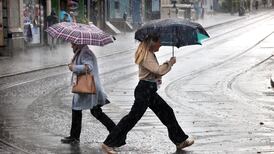A HANDWRITING expert told the High Court yesterday the disputed signature of Mr Proinsias, De Rossa on the "Moscow letter was a good forgery. Mr Michael Ansell, called by Mr De Rossa, was answering a question at the end of his evidence from Mr Justice Moriarty.
The article at the centre of the action had referred to a letter seeking funds which was allegedly sent by the Workers' Party to the USSR Communist Party in Moscow in 1986.
The judge asked that given that Mr Ansell had accepted under cross-examination by Mr Patrick MacEntee SC, for Independent Newspapers, that the reproduced signature presented as being fluent and flowing, did that mean that in all probability if it was a forgery, it was an exceptional and accomplished one.
Mr Ansell replied: "Yes, it's a good forgery."
Earlier, replying to Mr Paul O'Higgins SC, for Mr De Rossa, Mr Ansell said it was theoretically possible that Mr De Rossa wrote the disputed signature "which is why I did not say that he did not write it. I said he probably didn't write it, rather than he definitely didn't write it".
Mr Ansell said out of the 217 documents he was given with Mr De Rossa's signature to compare with the disputed signature, he did not see any "Ds" which resembled the D in the Moscow letter.
The overall appearance of the "D" in the disputed one was different from any "D" in the control samples. The "D" in the "De Rossa in the control samples gave the impression of being a lower case "d" but on the disputed signature it gave the impression of being a capital "D".
During cross-examination by Mr MacEntee, Mr Ansell said none of the samples of Mr De Rossa's signature looked like the signature on the Moscow letter
However Mr Ansell agreed that each of the six idiosyncracies he identified in the "Moscow letter" could be found in some samples of Mr De Rossa's writing.
Mr MacEntee listed six idiosyncracies which Mr Ansell had identified in the "Proinsias De Rossa" signature on the letter. He put it to Mr Ansell that all had been shown to exist in the supplied samples of Mr De Rossa's signature.
"What, then, are the idiosyncracies you're relying on?", he asked. Mr Ansell said that had not been his evidence at all. He said at no time had he agreed that the "D" in the letter was the same as any other "D".
Mr MacEntee said he thought they had agreed it was made with the same hand movement and hand gesture. Was not that the most telling thing? Mr Ansell said no, it was only one of the features.
Mr Ansell said no signature in the samples looked like the one in the letter. However, Mr MacEntee put it to him that when you examined the samples, the differences identified by Mr Ansell disappeared. The witness disagreed; some of Mr De Rossa's non-contemporaneous signatures had some of the same features "but that's as far as it goes".
Mr MacEntee said it was a question of Mr De Rossa's signature having all of the features (of the "Moscow letter" signature). Everyone of the six idiosyncracies which Mr Ansell contended existed in the letter signature had been found to occur in Mr De Rossa's writing. He asked if Mr Ansell agreed.
Mr Ansell I agree that each of those points can be found somewhere in the samples, yes."
Mr MacEntee also asked if, when Mr Ansell was examining a forged signature, would he expect to find evidence of hesitation, tremor or the pen being lifted or put down. Mr Ansell said it depended on the skill of the forger.
Mr MacEntee asked if he had found any of those when he was looking at the Moscow letter. Mr Ansell said there was no real evidence of hesitation, apart from the tops of the "55" and the points of the "T" and "D".









